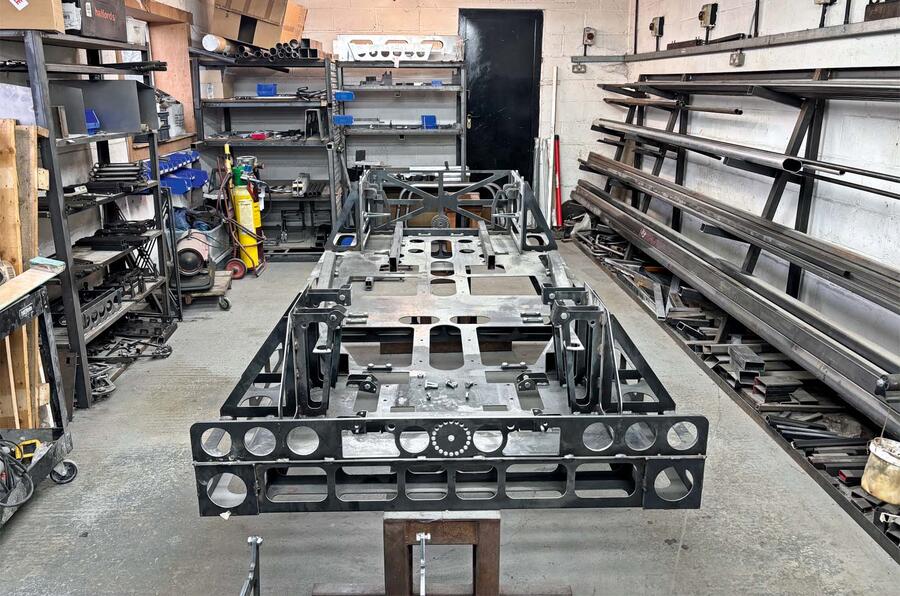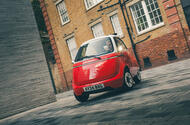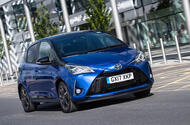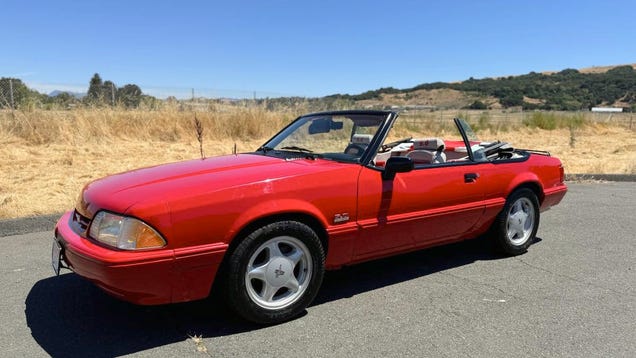Featured
“675kg Mika Meon: British Engineering Excellence | Giga Gears”
 Our road test editor dives into the technical make-up of the new VW Buggy-based EV
Our road test editor dives into the technical make-up of the new VW Buggy-based EV
Britain has a new lightweight sports car, the Mika Meon, and it has given me new hope about the potential of electrification within this particular micro-corner of the market.
Robin Hall and his team opened up the Mika office and workshop premises when I visited to test the Meon recently. Hall is a design engineer by trade. His company, Hall Engineering and Design, has been built on computer-aided design, which he does for all manner of clients.
He has a 3D printer in his office kitchen for producing prototype parts and a 3D scanner for the reverse engineering of existing ones. So there’s nothing antiquated, backwards or even particularly ordinary about this clean-sheet electric beach buggy design.
“Typically, the makers of niche sports cars like ours rely on a lot of parts bin components,” Hall told me.
“We’ve taken some off the shelf for the Meon, where that makes sense [ball joints, bushings and minor cabin components, for example]. But where we can get an advantage by designing our own parts – making them ourselves too, often – we will. That way, we needn’t adapt one part in order to squeeze in another; we get exactly what we want.”
The Meon’s brake calipers, for instance, are of Hall’s own design, machined from billet on site. Its front hub carriers are likewise proprietary, giving Hall ultimate control of attachment points and front-axle geometry (he previously designed the front hubs for the R50-generation Mini hatchback).
Hall is the kind of person who takes Henry Royce’s old maxim of “take the best that exists and make it better; if it does not exist, design it” rather seriously.
Mika’s chief technician, Dave Watt, showed me how the Meon’s chassis and axles come together. Lengths of tube- and box-section steel come in one door, finished chassis eventually go out of another and a lot of cutting, bending, bolting and welding of metal – much of it done by hand – goes on in between.

“Wishbones are the fiddliest,” said Watt, having first shown me how he cuts steel to size on a lubricated band saw (a device about the size of a coffee table, which would make a real mess of the place if it went wrong) and then forms it using a tube bender (a big ratcheted lever bolted to the floor that bends tubes around purpose-made blanks of particular radii).
“I can weld a whole chassis in less time than it takes to make a full set of wishbones.”
The welding is fascinating. Most of it happens on a purpose-made chassis jig (designed by Hall) that takes up a good chunk of the workshop floor itself.
It looks like something from a 1950s racing Ferrari, complete with cutouts for easy access to joins and rotisserie-style mountings so that it can be rotated around its middle.
This is production tooling in the classic sense, although it still produces build quality accurate to within a couple of millimetres across the car’s total length.
Watt slots each perfectly formed chassis member into it, then sets about joining them with spot welds first (“so the metal doesn’t warp and move as it cools”) and the bigger seam welds after.
When he’s finished, the Meon is four times more torsionally rigid than a Lotus Seven-style sports car typically is – and complete with batteries, seats, wheels and trim, it still weighs less than 700kg. Amazing.
As long as Britain’s cottage industry car business is in the hands of people like Hall and Watt, you can believe that they’re very capable and safe ones and they can still do remarkable things.
Microlino Review | Giga Gears
 Quirky, fashion-focused microcar is a Citroën Ami-sized EV for Kia Picanto money
The Citroën Ami is not a very good car, but then it's not really a car at all, rather a quadricycle. And besides, at less than £8000, it merits forgiveness of some of its more aggravating quirks and flaws. Despite its comparable dimensions and similar conception, you will find it distinctly harder to overlook any shortcomings of the new Microlino, which costs more than twice as much as its cubic contemporary.Revealed way back in 2016 and launched in Europe in 2022, the Microlino is the first 'car' from Switzerland's Micro Mobility Systems, founded in the late 1990s by Wim Ouboter, creator of the original foldable, two-wheeled aluminium scooter. Did you know there was originally meant to be one of those in the boot of every Smart car? Anyway, that never worked out, and there's clearly not as much money in the scooter game as there used to be, so Wim's son Merlin has taken the company boldly into the EV game with a tiny urban runaround modelled on the 1950s Isetta.Obvious stylistic influence from the era-defining 'bubble car' – famously built under licence by a nascent BMW – extends to a side-hinged front door, mirror-mounted headlights and a somewhat austere cockpit - although the Microlino's creators highlight the addition of a second rear wheel and, crucially, a reverse gear as key improvements.The Microlino is now available in the UK now through specialist vehicle retailer Krazy Horse, which conveniently will also sell you a Morgan Aero 8 supercar or a 2.5-tonne, 5.7-litre V8-engined Ram 1500 pick-up truck. Why go anywhere else?It's optimistic about the Microlino’s performance in the UK, targeting around 1000 sales here next year, and notes healthy demand from areas outside of the main cities – particularly on the south coast, where it will make a lot of sense, you’d imagine, as a holiday-home runabout.Motorhome owners have also emerged as a core demographic, to the extent that an Irish company is already designing a trailer specifically for the Microlino to be lugged along to the campsite, where it can be deployed for beach trips. But it will most naturally be at home as a second car for station runs and supermarket runs, with a footprint that lends itself to inter-urban errands and negotiating tight car parks - plus performance stats that stack up favourably against pretty much all of the same-sized alternatives, as you might hope, given the healthy premium it commands over each of them.
Quirky, fashion-focused microcar is a Citroën Ami-sized EV for Kia Picanto money
The Citroën Ami is not a very good car, but then it's not really a car at all, rather a quadricycle. And besides, at less than £8000, it merits forgiveness of some of its more aggravating quirks and flaws. Despite its comparable dimensions and similar conception, you will find it distinctly harder to overlook any shortcomings of the new Microlino, which costs more than twice as much as its cubic contemporary.Revealed way back in 2016 and launched in Europe in 2022, the Microlino is the first 'car' from Switzerland's Micro Mobility Systems, founded in the late 1990s by Wim Ouboter, creator of the original foldable, two-wheeled aluminium scooter. Did you know there was originally meant to be one of those in the boot of every Smart car? Anyway, that never worked out, and there's clearly not as much money in the scooter game as there used to be, so Wim's son Merlin has taken the company boldly into the EV game with a tiny urban runaround modelled on the 1950s Isetta.Obvious stylistic influence from the era-defining 'bubble car' – famously built under licence by a nascent BMW – extends to a side-hinged front door, mirror-mounted headlights and a somewhat austere cockpit - although the Microlino's creators highlight the addition of a second rear wheel and, crucially, a reverse gear as key improvements.The Microlino is now available in the UK now through specialist vehicle retailer Krazy Horse, which conveniently will also sell you a Morgan Aero 8 supercar or a 2.5-tonne, 5.7-litre V8-engined Ram 1500 pick-up truck. Why go anywhere else?It's optimistic about the Microlino’s performance in the UK, targeting around 1000 sales here next year, and notes healthy demand from areas outside of the main cities – particularly on the south coast, where it will make a lot of sense, you’d imagine, as a holiday-home runabout.Motorhome owners have also emerged as a core demographic, to the extent that an Irish company is already designing a trailer specifically for the Microlino to be lugged along to the campsite, where it can be deployed for beach trips. But it will most naturally be at home as a second car for station runs and supermarket runs, with a footprint that lends itself to inter-urban errands and negotiating tight car parks - plus performance stats that stack up favourably against pretty much all of the same-sized alternatives, as you might hope, given the healthy premium it commands over each of them. 2011-2020 Toyota Yaris Review | Giga Gears
 The third-gen Yaris was ahead of its time thanks to hybrid technology – but does it still appeal as a used buy?
It cuts a fairly sedate and predictable figure today, but the humble-looking third-generation Toyota Yaris was a good way ahead of its time when it was launched in 2011, combining innovative, wallet-busting hybrid technology with a tiny footprint, a surprisingly spacious interior and the Japanese manufacturer’s trademark unwavering dependability.Factor in a five-star safety rating, a wide range of well-equipped and clearly defined trim packages and used prices as low as £2000 and it’s hard to find a reason not to recommend it to a 17-year- old as their first set of wheels – or anyone in need of frugal, fuss-free motoring. Building on the almighty success of the Prius, Toyota saw an opportunity to install its hybrid technology in a smaller model – and it claimed to be the first to offer such a powertrain in this segment (although Honda had technically got there just before with the Jazz). Costing just under £17,000 when new, the Yaris Hybrid was pretty good value at the time, although its efficiency-biased 98bhp powertrain – based around a naturally aspirated 1.5-litre four-cylinder petrol engine – was roundly outpaced by zippier pure-petrol rivals and the exclusive use of a CVT meant it was pretty noisy at higher revs too.The trade-off was an eye-catching 75mpg combined, Toyota claimed. Impressive, even if the read-out was nearer 50mpg in the real world.There was also the option of two pure-petrol engines – a 68bhp 1.0-litre and a 98bhp 1.3-litre – as well as an 89bhp 1.4-litre diesel. The pokier petrol is our pick of the range. Its five-speed manual gearbox is easier to get along with than the frustrating CVT and its efficiency isn’t far off that of its electrically aided range-mate. The Yaris doesn’t handle quite as well as the contemporary Ford Fiesta or Volkswagen Polo, not helped by its lighter steering, and unkempt rural roads highlight a rougher edge to its dynamics, with the suspension struck dumb by bad potholes and bumps. Still, its comfortable seats and smart cabin help to make it a compelling alternative.Even the hybrid version, with its batteries sited under the back seats, has plenty of rear space, which is one reason why it’s often found these days loaded with sixth-formers on their way to grab a meal deal. The basic entry-level car, badged T2, doesn’t have enough kit to make it an attractive used buy.You will want at least a T4. The TR has enough equipment to feel like a relatively new car, including a touchscreen, electric mirrors and a reversing camera. The SR and T-Spirit range-toppers add the likes of sat-nav and dual-zone climate control. The trims were renamed as part of a restyle in 2014, with Active at the base and Icon, Sport and Excel swelling the kit roster. The Yaris was updated again in 2017 to keep pace with Ford and Volkswagen, with a light restyling and the 1.3-litre petrol swapped for a more efficient 1.5-litre.There was also the option of two-tone paint, updated infotainment and swisher materials for the range-topper. Whether you’re buying one as a first car or for short trips around town, the Yaris is a dependable supermini that is reasonably practical and affordable.Seek out a post-2014 car with the 1.3-litre petrol manual powertrain to get the smarter looks, more spritely performance and the tech and refinement to match many a newer alternative.
The third-gen Yaris was ahead of its time thanks to hybrid technology – but does it still appeal as a used buy?
It cuts a fairly sedate and predictable figure today, but the humble-looking third-generation Toyota Yaris was a good way ahead of its time when it was launched in 2011, combining innovative, wallet-busting hybrid technology with a tiny footprint, a surprisingly spacious interior and the Japanese manufacturer’s trademark unwavering dependability.Factor in a five-star safety rating, a wide range of well-equipped and clearly defined trim packages and used prices as low as £2000 and it’s hard to find a reason not to recommend it to a 17-year- old as their first set of wheels – or anyone in need of frugal, fuss-free motoring. Building on the almighty success of the Prius, Toyota saw an opportunity to install its hybrid technology in a smaller model – and it claimed to be the first to offer such a powertrain in this segment (although Honda had technically got there just before with the Jazz). Costing just under £17,000 when new, the Yaris Hybrid was pretty good value at the time, although its efficiency-biased 98bhp powertrain – based around a naturally aspirated 1.5-litre four-cylinder petrol engine – was roundly outpaced by zippier pure-petrol rivals and the exclusive use of a CVT meant it was pretty noisy at higher revs too.The trade-off was an eye-catching 75mpg combined, Toyota claimed. Impressive, even if the read-out was nearer 50mpg in the real world.There was also the option of two pure-petrol engines – a 68bhp 1.0-litre and a 98bhp 1.3-litre – as well as an 89bhp 1.4-litre diesel. The pokier petrol is our pick of the range. Its five-speed manual gearbox is easier to get along with than the frustrating CVT and its efficiency isn’t far off that of its electrically aided range-mate. The Yaris doesn’t handle quite as well as the contemporary Ford Fiesta or Volkswagen Polo, not helped by its lighter steering, and unkempt rural roads highlight a rougher edge to its dynamics, with the suspension struck dumb by bad potholes and bumps. Still, its comfortable seats and smart cabin help to make it a compelling alternative.Even the hybrid version, with its batteries sited under the back seats, has plenty of rear space, which is one reason why it’s often found these days loaded with sixth-formers on their way to grab a meal deal. The basic entry-level car, badged T2, doesn’t have enough kit to make it an attractive used buy.You will want at least a T4. The TR has enough equipment to feel like a relatively new car, including a touchscreen, electric mirrors and a reversing camera. The SR and T-Spirit range-toppers add the likes of sat-nav and dual-zone climate control. The trims were renamed as part of a restyle in 2014, with Active at the base and Icon, Sport and Excel swelling the kit roster. The Yaris was updated again in 2017 to keep pace with Ford and Volkswagen, with a light restyling and the 1.3-litre petrol swapped for a more efficient 1.5-litre.There was also the option of two-tone paint, updated infotainment and swisher materials for the range-topper. Whether you’re buying one as a first car or for short trips around town, the Yaris is a dependable supermini that is reasonably practical and affordable.Seek out a post-2014 car with the 1.3-litre petrol manual powertrain to get the smarter looks, more spritely performance and the tech and refinement to match many a newer alternative. “BMW Sets New Standard for EV Flexibility | Giga Gears”
 BMW was seen as a laggard in retaining hybrid flexibility – but several naysayers have now followed suit
BMW was seen as a laggard in retaining hybrid flexibility – but several naysayers have now followed suit
Just ahead of his elevation to the position of CEO at BMW in 2019, then production head Oliver Zipse spoke at an event at the Mini plant in Oxford about the need for caution when it came to EVs.
“Flexibility is key,” he told journalists. “If we predict the success of 3 Series, we can be pretty much spot-on. To predict electro-mobility is much more difficult.”
Five years later BMW is reaping the rewards of its more circumspect strategy. In July the company actually sold more electric cars in Europe than the global EV leader Tesla, according to market research firm Jato Dynamics.
But BMW’s electric cars are even today still just adapted versions of combustion engine models, built on the same production line.
Back in 2019, BMW stood in opposition to Volkswagen Group, who was about to show the first model on its all-electric MEB platform built in a plant outfitted for just that platform. Indeed, the ousting of Zipse’s predecessor Harald Krueger was widely attributed to his failure to provide clarity on BMW’s own electric strategy after becoming a pioneer with the well-liked but costly i3.
BMW gambled on a cautious approach. Rather than redesigning the car to unlock the potential of the electric drivetrain, for example by liberating more cabin space as VW claimed, BMW offered electric as just another drivetrain choice. “You won’t feel difference as a customer. You maybe will find 2kg here and 2kg there, but that is not relevant for a buying decision,” Zipse said back in 2019.
Fast forward five years BMW is not only Europe’s number two EV seller behind Tesla year-to-date, but profits are buoyant at 3.7 billion euros in the second quarter to the end of June, translating into a margin of 10.5%. Zipse has earned his boast about the firm’s achievements. “Many years ago, we bet on the right strategy to be as flexible as possible,” he said on the company’s second quarter earnings call. “You're better prepared if you have ultimate flexible portfolio and an ultimate process competence to react to these things.”
This much cheaper strategy is now seen as the gold-standard for companies as they recalibrate for a lumpier demand in electric vehicles than expected. “Car companies at the moment are forced to work with two three drivetrains, BEV, hybrid or ICE. What we see is that flexibility is very valuable,” Ingo Stein, head of the automotive division for the Bain & Company consultancy, “You can balance the demand shift much easier than a company that produces different cars with different drive trains.”
In Europe and particularly the US, companies are shifting more of their production to hybrids after the expected EV boom hasn’t materialised at the speed first envisaged after Tesla’s original spectacular stock rise.
Hyundai for example is switching its planned new electric-only “Metaplant” in Georgia, US, to build hybrids as well to bridge what it calls the “chasm” to EV demand. “We've seen very clearly a trend in the market demanding more hybrid, so we decided to be flexible and introduce hybrid into our Metaplant,” Jaehoon Chang, President and CEO of Hyundai Motor Company, told investors late in August.
Hyundai is projecting to sell 1.33 million hybrids globally by 2028, up 40% on its previous plan. It also plans a rollout of extend-range electric vehicles (EREVs).
Ford is another looking for flexible options after delaying plans for an all EV plant in Tennessee on the cancellation of its previously announced three-row (ie seven-seat) electric SUV. “You have to have a compelling product roadmap and you have to have very flexible manufacturing,” Ford CEO Jim Farley said on the company’s second quarter earnings call.
Ford’s van strategy has embraced that flexibility at its plants in Turkey, where the Transit Custom and related VW Transporter are built as plug-in hybrid, EV or diesel on the same line.
Plenty of other manufacturers have adopted the flexible approach too. Stellantis even builds a fuel-cell version of its ‘K-Zero’ line of midsize vans including the Opel Vivaro at its plant in Hordain, France, alongside electric and diesel versions. Stellantis said this was done in accordance with its “ethical desire not to separate its electric and internal combustion engine businesses, to engage all its employees in the energy transition”.
Unplanned flexibility however can be expensive, especially when you were banking on EVs forming a greater portion of sales earlier in the cycle. Jaguar Land Rover for example announced earlier this year it had increased its five-year investment plan from £15 billion to £18 billion after the slower-than-predicted EV take-up forced it to boost spending on flexible platforms that allow combustion engines as well as electric.
The hike to £18 billion is “partly because we are having to invest more in keeping the parallel running of flex vehicles BEV vehicles and ICE Vehicles going for longer than we anticipated as the industry trend towards BEV globally starts to slow down from previous expectations,” JLR chief financial officer Richard Molyneux told analysts at the company’s investor day in June.
JLR is continuing to build combustion engine models at its Halewood plant, home of the Range Rover Evoque and Land Rover Discovery Sport, even after it begins production of electric models on a new platform.
JLR’s tardiness into the EV market is a good thing, the company said. “Many competitors have placed their bets, done their investment, launched their cars and quite a few have regretted it. It's one of the advantages of being a follower rather than being first in the market,” Molyneux said.
Volvo meanwhile has been forced by customer demand to upgrade its XC90 large SUV and extend production at its Torslanda, Sweden, plant after initially saying it would be replaced by the new electric EX90. It also will extend the life of other combustion and hybrid models even as it rolls out EVs on new platforms. “In this transition period from an ICE world to a BEV world, we can temporarily have a broader product portfolio,” Björn Annwall said during an investor event September 4.
Ultimately carmakers are having to commit to dedicated electric platforms as they seek to extract all the cost and technology benefits that come from dumping the multi-fuel approach.
BMW for example next year will launch the first of its models on the dedicated Neue Klasse electric platform, expected to be an electric SUV previewed by the X concept.
BMW is investing €2 billion in the new battery-making and assembly operations for the Neue Klasse at a plant in Hungary.
BMW hopes the Neue Klasse cars, with their promised 800-volt architecture enabling fast charging, will be appealing enough to drive sales to the point they can sustain whole plants, but the gamble remains.
Ultimately companies are still dealing with the same unpredictable nature of the EV transition as Zipse highlighted back in 2019. Waiting for a long as possible to scrap profitable combustion engine models will help them navigate that.
“1993 Ford Mustang LX 5.0 for $13,900: A Goosebumps Ride?”

In the wild, an ostrich can run faster than a horse. In today’s Nice Price or No Dice Mustang, that’s been evened up, as this pony wears pimply ostrich upholstery along with its red velour seating. Let’s decide what such an expressive combo might properly fetch.

